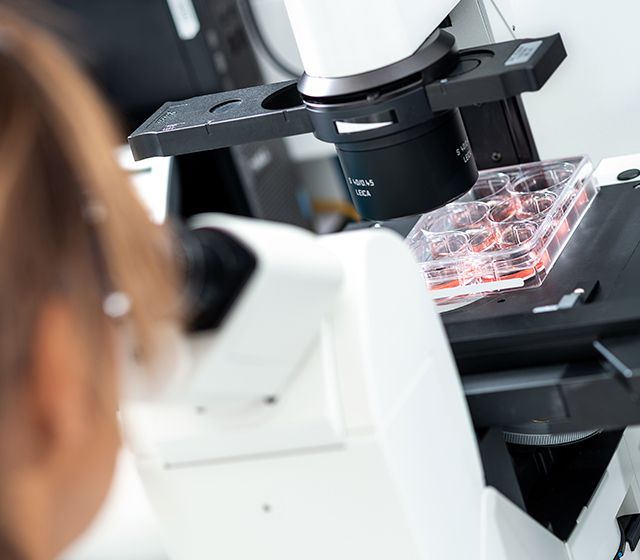Neuroscience
Alzheimer's Disease (AD)
Alzheimer’s disease (AD), the most common cause of dementia, is a progressive neurodegenerative disorder affecting more than 40 million people worldwide.
Hallmarks are the presence of senile plaques and neurofibrillary tangles, surrounded by damaged neurons. b-Amyloid 1-42 is a major component of the plaques, and many studies suggest that it may form toxic oligomers and fibrils under physiological conditions. The pathogenic b-Amyloid 1-42 (AD) or the non-pathogenic peptide P3 (healthy individuals) are processed from the Amyloid Precursor Protein by Secretases (α, b, g).
b-secretase, but also other proteases including Glutaminyl Cyclase, Insulin Degrading Enzyme, Endothelin Converting Enzyme, Meprin b, Peptidyl Prolyl Isomerase and Neprilysin have been linked to the processing of b-Amyloid 1-42 and as such, they are considered as potential therapeutic and/or diagnostic AD targets.
Monitoring the activity of key proteases is useful in drug discovery and to screen for protease inhibitors. We constantly innovate to provide the best portfolio of quantitative assays, most being based on the FRET principle using proprietary substrates. As a world leader in FRET peptide technology we are proud to offer the same variety of long wavelength quencher and dye pairings used in our catalog peptides.
There is currently high interest in studying the aggregation process of b-Amyloids, which can be addressed using the SensoLyte® Thioflavin T β-Amyloid Aggregation Kits.
Our SensoLyte® Assay Kits enable extensive detection of protease activity to be faster, easier and compatible with HTS.
Multiple Sclerosis (MS)
MS is an autoimmune disease affecting the brain and spinal cord, whereby autoimmune antibodies are raised to some myelin components including myelin oligodendrocyte glycoprotein (MOG), myelin basic protein (MBP) and myelin proteolipid Protein (PLP). This leads to nerve demyelination and subsequent nerve damage. It is the most common demyelinating disease with a varied global prevalence.
Induced Experimental Autoimmune Encephalomyelitis (EAE) is a frequently used animal model of MS, which may be generated by injecting MOG, MBP or PLP proteins or key peptide fragments thereof into animals, most often rats or mice.
AnaSpec (Eurogentec's US subsidiary) was pioneer in developing the first ELISA kits for monitoring the presence of anti-MOG and anti-PLP autoantibodies in body fluids.
Our MOG kits are flexible, as they can detecting autoimmune IgGs against mouse/rat MOG (35-55), rat MOG (1-125), mouse MOG (1-125) or human MOG (1-125). The latter is adapted to either human or mouse samples.
FRET substrates
FRET occurs between a peptide tagged to a donor and an acceptor when placed within 10-100Å of each other resulting in the donor’s excitation fluorescence to be quenched by the acceptor. Enzymatic hydrolysis of the peptide results in recovery of the donor fluorescence following spatial separation of the donor and acceptor upon energy transfer.
| Dye (donor) | Quencher (acceptor) | Donor Ex/Em | |
| SensoLyte® 390 | Mca | Dnp |
•
325/393 nm |
|---|---|---|---|
| SensoLyte® 490 | EDANS | DABCYL |
•
340/490 nm |
| SensoLyte® 520 | 5-FAM or HiLyte™ Fluor 488 | QXL®520 |
•
494/521 nm |
| SensoLyte® 570 | 5-TAMRA | QXL®570 |
•
547/574 nm |
Fluorogenic substrates
These substrates do not require a quencher and contain a C-terminal dye that does not fluoresce until it is cleaved from the peptide (fluorescent form of dye is released).
| Dye (donor) | Donor Ex/Em | |
| SensoLyte® AMC | AMC |
•
351/430 nm |
|---|---|---|
| SensoLyte® AFC | AFC |
•
382/480 nm |
| SensoLyte® Rh110 | Rh110 |
•
501/527 nm |
